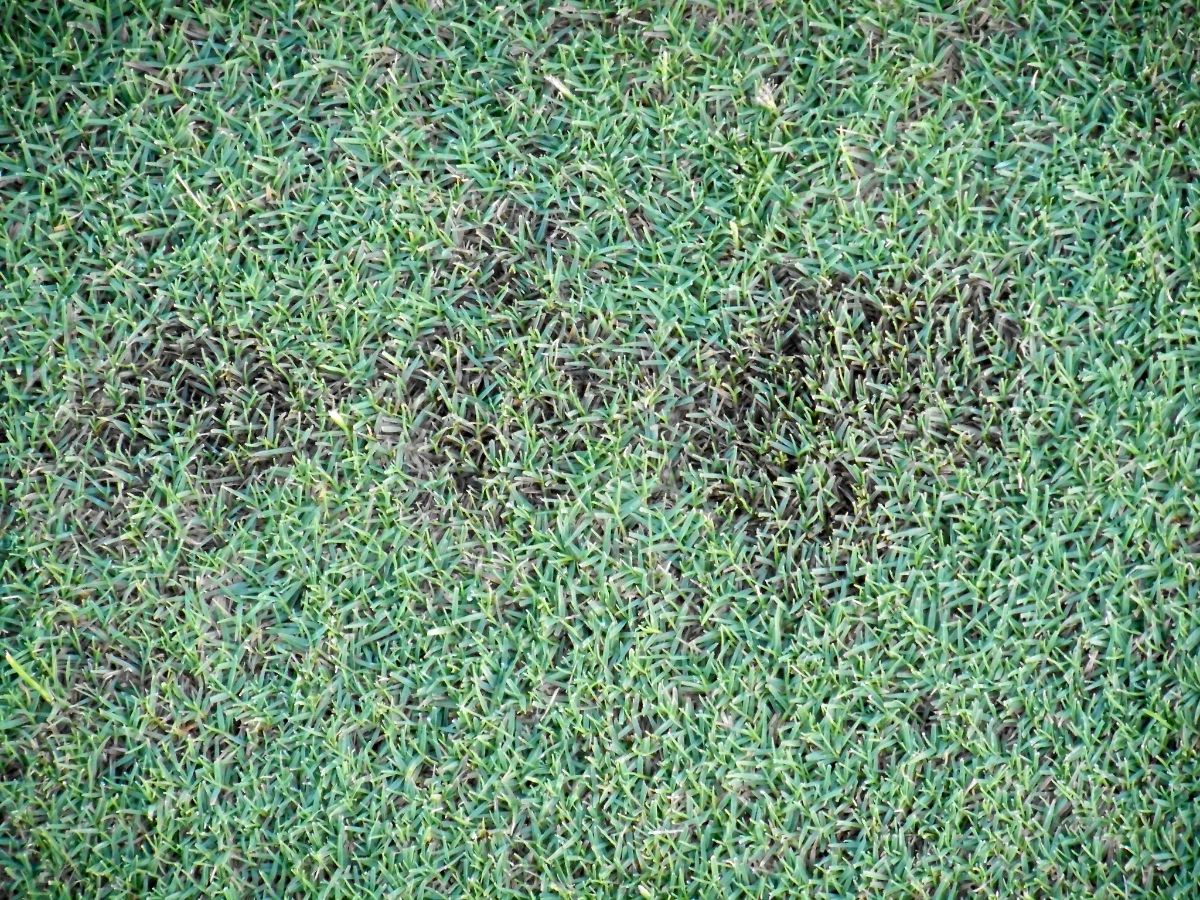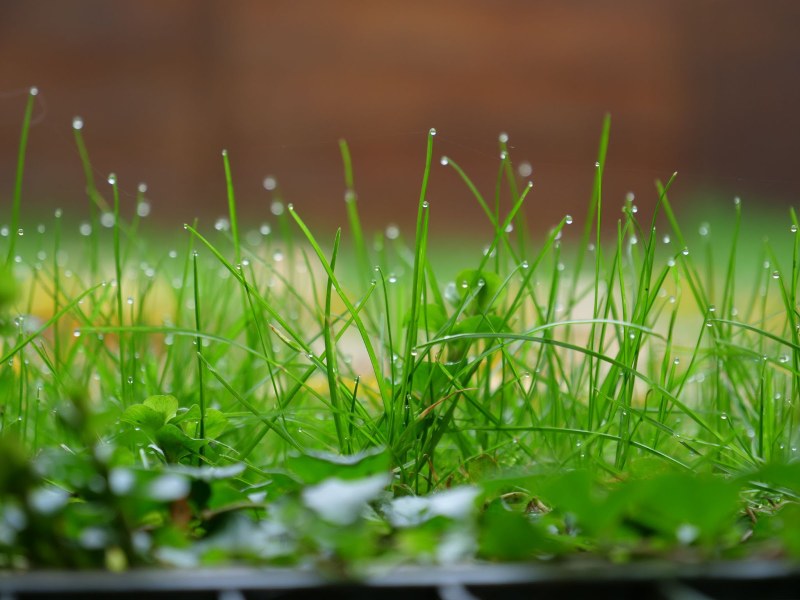
Dollar spot is the most common fungal lawn disease in the United States. Caused by Clarireedia fungi, it spreads through wind, water, equipment, and foot traffic, infecting all warm- and cool-season grasses.
It creates circular patches of bleached grass 1-5 inches wide that grow and merge and can infect 90% of the grass if left untreated. The good news? Our experts explain that it rarely kills the grass permanently, and it’s manageable if you understand what dollar spot is and what helps it thrive.
Signs and Symptoms of Dollar Spot

While brown spots can signal anything from dog pee to lawn diseases, there are specific signs that help with dollar spot identification when it‘s the underlying cause.
Note: If you’re not sure what’s damaging your lawn, hire a lawn treatment pro.
Primary Dollar Spot Symptoms

The three main signs of dollar spot fungus to always look for are:
- Circular, straw-colored patches 1-5 inches wide with sunken centers
- Tan leaf lesions with reddish-brown margins forming from the blade tip downward
- White cottony mycelium visible on the grass during morning dew
Mowing height affects appearance: On closely cut grass, dollar spot disease appears as well-defined, round patches about 1-2 inches wide, while in tall grass, it creates larger, more irregular spots.
Professor and Extension Plant Pathologist Alfredo Martinez-Espinoza from the University of Georgia explains that the name dollar spot is derived from the small, circular patches that resemble silver dollars.
Advanced Dollar Spot Symptoms
As the disease spreads, small patches join together into larger areas of thinned, stunted grass, often invaded by weeds.
“If left unmanaged, dollar spot can affect entire turfgrass swards,” says Martinez-Espinoza.
In severe cases, the grass can die off completely, leaving you with patches of bare soil.
Dollar Spot vs. Similar Diseases
Dollar spot patches can look a lot like brown patch and Pythium blight. Use these comparison tables to tell them apart.
Brown patch vs. Dollar Spot

Photo Credit: Scot Nelson / Wikimedia Commons / CC0 1.0
| Distinctive Features | Brown Patch | Dollar Spot |
| Patch size | 6+ inches | 1-5 inches |
| Color | Reddish-brown patches | Bleached, tan patches |
| Shape | Irregular donut-like patches | Round or irregular patches |
| Mycellium | Ring of grayish mycelium on patch periphery | White fuzzy mycelium across the patch |
Pythium Blight vs. Dollar Spot

Photo Credit: NC State Cooperative Extension
| Distinctive Features | Phytium Blight | Dollar Spot |
| Leaves | Dark green to copper, greasy, and flattened. No leaf markings. | Distinct tan leaf lesions with brown edges |
| Patch color | Tan to brown patches with an orange or purplish border | Bleached, tan patches |
| Shape | Irregular patches following watering and mowing patterns | Circular or irregular patches |
What Causes Dollar Spot?

Dollar spot lawn disease is caused by a sneaky fungus (Clarireedia jacksonii) that targets wet and weakened grass blades. It spreads through tiny white fungal threads that travel by wind, water runoff, your shoes, and lawn equipment.
During the cold season, the fungus survives in thatch and infected dormant grass. It returns in the spring when temperatures range between 60 and 85 F and there’s plenty of moisture.
Where and When Dollar Spot Occurs
Whether dollar spot disease hits your lawn this season comes down to two things: how you feed and water your turfgrass.
The science is clear on what this fungus loves most: “Dollar spot prefers low nitrogen and high leaf wetness,” explains Paul Koch, plant pathology professor at the University of Wisconsin-Madison.
In practical terms, if you’re skimping on fertilizer — Koch says anything under 2 pounds of nitrogen per 1,000 square feet annually — and keeping your grass wet with frequent watering, you’re creating ideal conditions for dollar spot fungus.
| Keep dollar spot at bay with professional lawn treatments. Our pros charge, on average, $106 per treatment and use the right fertilizer to keep the lawn healthy and strong. |

But improper irrigation isn’t the only culprit. Heavy morning dew — common when hot days meet cold nights — creates the perfect breeding ground. Koch warns homeowners to watch their weather apps.
“Look at the overnight low temperatures. When they are consistently in the low 70s, that indicates very humid conditions that may be suitable for dollar spot development,” says Koch.
While spring and fall are prime time for this disease, don’t let your guard down. Most temperate regions see favorable conditions from May through October. The timing varies by location — Mid-Atlantic regions can see year-round problems peaking in the summer, while the South might get a summer break.
“Areas that routinely see daytime high temperatures in the 90s may get too hot for dollar spot,” says Koch.
What Type of Grass is Most Susceptible to Dollar Spot?
Dollar spot isn’t choosy about the grass type it uses as host — it can infect virtually any lawn, whether warm- or cool-season species. Some of the turfgrasses most susceptible to dollar spot are:
While no turfgrass is 100% resistant to dollar spot, species like tall fescue, fine fescues, or perennial ryegrass, weather it better if properly cared for. Scientists have also developed more resistant cultivars for most turf types, such as Kentucky bluegrass ‘Midnight’ and Bermudagrass ‘Mirage 2’.
Prevention and Treatment
There’s no single management strategy, says Martinez-Espinoza. Instead, dollar spot management “has to be a multipronged approach,” he explains.
Koch agrees, explaining that proper fertilization and watering can help limit this disease.
“Fertilizing adequately, limiting overall irrigation, and only irrigating in the morning hours will help to reduce dollar spot,” says Koch.
Building on these fertilization and watering fundamentals, homeowners aiming to control dollar spot should also:
- Remove heavy morning dew daily.
- Mow at the proper height and dispose of the infected grass clippings.
- Prune trees to allow better airflow and sun exposure.
- Remove thatch over 1/2 inch thick and aerate compacted soil.
- Rotate dollar spot fungicides to prevent fungicide resistance or seek professional lawn treatment for severe infestations.
- Plant cultivars that are more resilient to dollar spot.
FAQ
Lawns treated with fungicides typically take at least a month and multiple fungicide applications to recover. Proper fertilization can speed up the process.
The best time to apply preventive fungicides for dollar spot is in the spring, before the first symptoms appear or as soon as signs of dollar spot are visible on the lawn.
Yes, you can, but with some precautions. Use sharp blades, mow the infected areas last, remove the grass clippings from the lawn, and sanitize the lawn mower afterward to avoid spreading the fungi.
When to Call the Pros
If the lawn is already stressed or you notice dollar spot late, it’s better to call the pros. Rely on LawnStarter’s lawn treatment experts for effective fungicide applications that keep your turf thriving and fungi-free.
Our pros can also help you prevent reinfestation by keeping the lawn in perfect shape with flawless mowing, aeration, dethatching, and fertilization.
Sources:
- Alfredo Martinez-Espinoza, professor in the Department of Plant Pathology and Extension specialist at the University of Georgia, Griffin, GA. Personal interview.
- “Dollar Spot Already Returning in 2025: Be Prepared.” By Geunhwa Jung, professor of turfgrass pathology. University of Massachusetts.
- “Dollar Spot Of Turfgrasses in Georgia: Identification and Control.” By plant pathology experts Alfredo Martinez-Espinoza, Elizabeth Little, Kimberly Toal, and Brian Vermeer. University of Georgia.
- “Dollar Spot of Warm-Season Turfgrasses.” By Alan Henn, Extension professor, Missouri State University Extension.
- Paul Koch, professor in the Department of Plant Pathology at the University of Wisconsin-Madison, Madison, WI. Personal interview.
Main photo credit: Scot Nelson / Flickr / Public domain